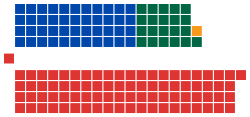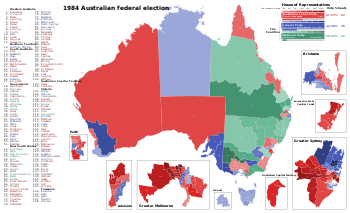|
1984 Australian federal election
The 1984 Australian federal election was held in Australia on 1 December 1984. All 148 seats in the House of Representatives (24 of them newly created) and 46 of 76 seats in the Senate (12 of them newly created) were up for election. The incumbent Labor Party led by Prime Minister Bob Hawke defeated the opposition Liberal–National coalition, led by Andrew Peacock.[1] The election was held in conjunction with two referendum questions, neither of which was carried. Background and issuesThe election had a long campaign and a high rate of informal voting for the House of Representatives, but decreased rate in the Senate (due to the introduction of the Group voting ticket). Although a House election was not due until 1986, Hawke opted to call an election 18 months early in part to bring the elections for the House and Senate back into line following the double dissolution election of 1983. The legislated increase in the size of the House by 24 seats and the Senate by 12 seats came into effect at the 1984 election. Prior to 1984 the electoral commission did not undertake a full distribution of preferences for statistical purposes. The stored ballot papers for the previous election were put through this process prior to their destruction – therefore the figures from 1983 onwards show the actual result based on full distribution of preferences. ResultsHouse of Representatives Labor (82) Opposition (66) Coalition Liberal (44) National (21) CLP (1)
Senate Labor (34) Opposition (33) Coalition Liberal (27) National (5) CLP (1) Crossbench (9) Democrats (7) NDP (1) Independent (1)
Seats changing hands
Analysis The results of the election surprised most analysts;[citation needed] the expectation had been that Bob Hawke – who had been polling a record ACNielsen approval rating of 75 percent[2] on the eve of the election – would win by a significantly larger margin. Labor instead suffered a 2-point swing against it and had its majority cut from 25 to 16. Hawke blamed the result on the changes to Senate vote cards, which he believed confused people regarding their House of Representatives votes and contributed to the relatively high informal vote, the majority of which apparently was Labor votes.[3] However, analysis by the Australian Electoral Commission found that informal voting only slightly reduced Labor's primary vote and did not change the result in any division.[4] Andrew Peacock did well from a good performance in the one leaders' debate, held on 26 November 1984,[5] which was the first televised leaders' debate in Australia.[6] It was because of Peacock's performance at the leaders' debate that Hawke refused to debate John Howard for the 1987 election. Ironically when Hawke agreed to do the leaders' debate for the 1990 election it was again with Peacock. See also
References
External links
|
|||||||||||||||||||||||||||||||||||||||||||||||||||||||||||||||||||||||||||||||||||||||||||||||||||||||||||||||||||||||||||||||||||||||||||||||||||||||||||||||||||||||||||||||||||||||||||||||||||||||||||||||||||||||||||||||||||||||||||||||||||||||||||||||||||||||||||||||||||||||||||||||||||||||||||||||||||||||||||||||||||||||||||||||||||||||||||||||||||||||||||||||||||||||||||||||||||||||||||||||||||||||||||||||||||||||||||||||||||||||||||||||||||||||||||||||||||||||||||||||||




